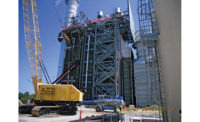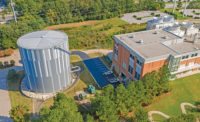Arizona State University Combined Heat & Power Facility Upgrade
Tempe, Ariz.
Best Project
Owner/Developer: Arizona State University
General Contractor: McCarthy Building Cos.
Lead Design Firm, MEP Engineer: R.G. Vanderweil Engineers
Subcontractors: Rosendin Electric; Schuff Steel; Roofing Southwest; Thermo Systems; Berg Drywall; Preferred Insulation
Because they’re located in the center of Arizona State University’s busy campus, key research buildings needed an even-more-reliable power source. This upgrade doubled the power facility’s capacity and allows for future campus growth. Another benefit is that ASU now has total independence from the electrical grid in the event of a power outage or other emergencies.
The upgraded facility uses less gas and energy than the existing turbine, reducing annual boiler-steam production by 80% and reducing purchased electricity by 30%, or 40,000 MW hours. Operating on a 24-hour basis, the Combined Heat & Power Facility produces more than 7 kW of power and 90,000 lb of steam per hour.
The heart of the upgrade is a new T-70 Solar turbine generator and heat-recovery steam generator, along with a dozen ancillary systems, which include fuel gas pumps and filters, a 3,750-gallon-per-minute cooling tower, a new boiler-feed water system, ammonia transfer pump, additional chilled water, potable and service water flow and two raw-water booster pumps.
The heat-recovery steam generator required a 115,000-lb crane pick with a 550-ton capacity crane. The existing turbine had to remain fully operational while the second unit was being installed.
To prevent shutdowns caused by sparks, a large, flash-resistant screen was hung between the two units. Gas-powered solar turbines have “fire eyes” that will shut the unit off when any type of spark is detected. Since the existing solar turbine had to remain fully operational during installation of the second unit, sparks from normal construction activities like welding had to be kept away from it.
Since there are no off-hours on a university campus, plans were distributed to all staff and ASU emergency personnel at least a week before the project started. The plans specified barricaded areas, direction of pedestrian traffic, impacts on the nearby parking garage, an emergency personnel route and the time and duration of each phase. A scheduled outage for plant maintenance allowed developers to perform more than 50 tie-ins during a two-week period.
Back to "ENR Southwest's 2019 Best Projects: Innovation, Skillful Renovations Lauded"





Post a comment to this article
Report Abusive Comment